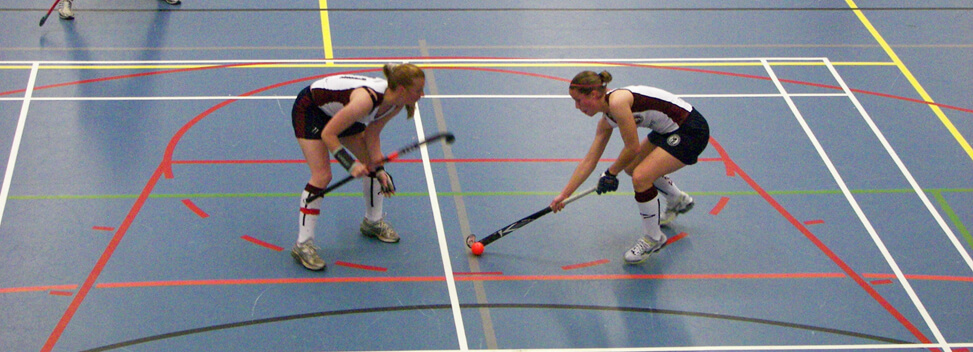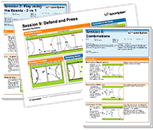FIH indoor hockey rule changes and you
- November 14, 2013
- Bram Van Asselt

Photo credit to fourthandfifteen on Flickr
Watch this space. Over the coming weeks we'll begin to explore the impact of the new indoor hockey rules to try and keep your team a step ahead of the opposition.
As of 1st September 2013 indoor hockey is to be played with 5 players, not 6.
This major change has left many players and coaches scratching their heads. We at Sportplan have given it some thought and this is how we think it will affect the game for the better. In this post we explore the ares of the indoor game it may impact on, ie. keepers, equipment, more space and formations.
Early thoughts:
1. Keepers become more important
We believe gone are the days when keepers stand in goal and made a few saves. Keepers have always been required to more active indoor compared to outdoor, but early thoughts seem to tell us that they are just about to become as active as the outfield players if teams are going to make the most of the new rules.
This is an exciting time for keepers it looks like they could become more involved, as an extra player, as an extra player to gain the overload when their team is in possession and as a covering defender in defence (putting pressure on a free forward in the circle). If this is the case then goalkeeper equipment may start to change to allow keepers to be more mobile and possibly so they can hold the stick in two hands.
 Yes - New equipment: If keepers become more mobile we think short corners might have to be accepted as goals, therefore not giving them away will become of even greater importance than before. So if this happens we think pads might become lighter and thinner and the left glove might become more similar to ice hockey to allow keepers to hold their sticks with both hands.
Yes - New equipment: If keepers become more mobile we think short corners might have to be accepted as goals, therefore not giving them away will become of even greater importance than before. So if this happens we think pads might become lighter and thinner and the left glove might become more similar to ice hockey to allow keepers to hold their sticks with both hands.
 No - New equipment: If the keeper does not become more mobile teams may have to consider playing without a keeper for periods of time (with 5 outfield players).
No - New equipment: If the keeper does not become more mobile teams may have to consider playing without a keeper for periods of time (with 5 outfield players).
2. Fewer players = more space
Going from 6 to 5 a-side means there is more space for players, therefore the temptation to run with the ball will also be bigger, and in the early days of the new rule we think this will lead to players losing possession more with more break always. Of course it will still be very important to be patient, if not more patient than before, with the ball as any mistake will be hard to cover - and a lot more tiring with more running for defenders (less so if GKs playing a bigger role).
Also the highly skilled players that are able to play 1v1 well will have a great time with the extra space, if they donât lose possession. But ultimately it looks like break hockey will more often than not beat possession hockey.
The video (below) shows the obvious way of playing with the new 5v5 rule and shows the GK standing back and only occasionally taking part in defence
This video also shows the space that could be explored. For instance if the keeper was to step up to restart the game from the top of the circle this would allow one of the wide defenders to push up in attack.
3. Likely formations and tactics:
In the early stages we think man to man at the back will become more effective as zonal defence becomes even harder with the additional space.. The keeper will also have to be ready to play more 1v1 situation and players in possession will have to resist the temptation to run with the ball too much.
To our eye it seems the most recommended formation is 1-2-1, with one defender, one attacker and two attacking defenders. These players have to drop back in defence when your team has not got the ball and ready to attack when your team wins possession.
 I've gone into more detail on Formations for the indoor 5 player game here. Full members can view this session as part of their subscription to Sportplan Hockey. If you've bought our indoor session pack check it again, this formations plan has been added to your pack for your convenience.
I've gone into more detail on Formations for the indoor 5 player game here. Full members can view this session as part of their subscription to Sportplan Hockey. If you've bought our indoor session pack check it again, this formations plan has been added to your pack for your convenience.
Final thoughts:
The indoor equivalent of Hockey5s is going to require and create more all round players being able to play total hockey, with the following key skills -
- Plenty of speed
- Excellent ball skills (even keepers)
- An eye for goal
- Accurate passing ability
- Good vision and decision making
Related Content
 |
 |
 |
| Indoor Hockey: Hook dribble pass | Indoor Hockey: Training programme | Indoor hockey: 2v1 using the boards |